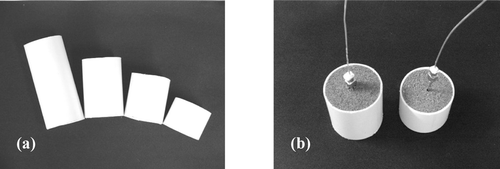Abstract
The influence of meat sample dimensions on the mass transfer coefficient (kS) of precooked cuts of pork, beef, and chicken during vacuum cooling, as well the behavior of this coefficient during the vacuum cooling process, were investigated. It was evidenced that the kS parameter presented statistical correlations with sample volume. The strongest dependence was found for precooked breast chicken, showing that this product can be cooled by vacuum impregnation. Knowledge of this dependence is important in order to evaluate the dimensions and geometric formats of meat cuts to be treated by vacuum cooling. Experiments with cylinders filled with moist sand showed that for porous materials kS can be considered proportional to the sample volume, and that the initial moisture content influences the internal temperatures during the cooling process. Knowledge of the kS behavior, with respect to sample volume, aids an understanding of the water evaporation and temperature decrease during the vacuum cooling of porous foods.
Keywords:
INTRODUCTION
Food industries that process meat need to cool these products rapidly after cooking processes. Vacuum cooling is a good alternative when a short cooling time is required for a food. Moreover, there is no contact between the product and cooling water or cold air, minimizing possible microbial contamination during this step, since cooking and cooling can be performed in a same tank. The vacuum cooling process is based on the heat removal of a product by its free water evaporation.[Citation1–4] To maintain the water evaporation, an ambient pressure (chamber pressure) reduction must be ensured until reaching the pressure that allows the attainment of a desired temperature.
The main requirements for the commercial use of vacuum cooling are: (a) the product should have a large surface area for mass transfer, (b) product water loss should not represent an economic or sensory problem, due to weight reduction and possible changes in structure or appearance.[Citation2] The total amount of evaporated water (weight loss) during the vacuum cooling of a food can be estimated approximately by EquationEq. (1).[Citation4, Citation5]
For meat products, most vacuum cooling investigations have been carried out on pieces of pre-cooked meat and fish, although whole hams and joints have also been studied.[Citation9–14] The vacuum cooling of precooked mussels (Perna perna) has been reported by Huber et al.,Citation[15] who suggested that the use of this technique for the pre-cooling of the mussels before manual removal from their shells, which must be performed at temperatures below 40°C.
It is apparent, therefore, that the results reported in the literature have demonstrated the viability of the application of vacuum cooling to products which do not have a large external surface area, like meat cuts. Self et al.[Citation16] investigated the effect of the cooking pressure and of the pressure reduction rate in the vacuum chamber on the efficiency and quality of chicken breast. The results indicated that the pressure reduction rate did not affect the quality of chicken breast. McDonald and Sun[Citation17] have determined the weight loss of cooked beef products submitted to vacuum cooling. For a decrease of 68°C, under different pumping rates, weight losses ranged from 10.66% to 12.40% of the initial product weight. For studies on the use of vacuum to cool precooked tuna, weight losses ranged from 3–4%, for a temperature decrease of around 30°C.[Citation2]
A compilation of literature data of mass transfer coefficient in food processing was presented by Krokida et al.[Citation18] Other researchers have demonstrated the importance of knowledge of process parameters that control the water loss during the vacuum cooling process.[Citation1, Citation3, Citation5, Citation19, Citation20] Landfeld et al.[Citation14] proposed a mathematical model to predict the time-temperature evolution during vacuum cooling. The use of a “mass transfer coefficient” was proposed, defined as the ratio between the evaporation rate , and the difference between the chamber pressure and the water saturation pressure (P − Psat
) at the sample temperature, for a time interval. This definition is represented by EquationEq. (2), where k is the evaporation coefficient (g cm2 s−1 Pa−1), S is the useful evaporation area (cm2), P is the chamber pressure (Pa) and Psat
is the water saturation pressure at the food temperature (°C).
In fact, under vacuum conditions the chamber atmosphere is composed almost entirely of water vapor, and there is no mass transfer in the phenomenological sense, but rather water evaporation controlled by the chamber evacuation rate. Thus, it would be better to denominate the k parameter by evaporation coefficient.
Considering that water evaporation can take place at the external surface of the food as well as in the internal pores that are connected with the external surface, the effective area for evaporation is proportional to food volume according to EquationEq. (3).[Citation14]
Zhang and Sun[Citation21] evaluated the vacuum cooling of precooked carrots and observed that the weight loss of sliced samples was 20.04%, while for whole samples it was 12.14%. These results suggest that water evaporation occurred preferentially at the external surface and not in the internal pores. Landfeld et al.[Citation14] performed vacuum cooling experiments with precooked carrots, potatoes, pork meat, and chicken breast. The authors reported that the kS values were not correlated with sample volumes for carrots and potatoes. For meat cuts, they found that linear functions represented the relation between the kS parameter and sample volume for beef steak (R2 = 0.7744) and chicken breast (R2 = 0.7003). For pork steak, no correlation was found between the kS value and the sample volume for the range investigated. The objective of this work was to determine the influence of the sample dimensions on the evaporation coefficient (“mass transfer coefficient”) of precooked cuts of pork, beef, and chicken during vacuum cooling, as well as to investigate the behavior of this coefficient during the vacuum cooling process.
MATERIALS AND METHODS
Sample Preparation and Cooking
Raw meat samples were purchased at a supermarket in Florianópolis, SC, Brazil and used to prepare boneless and skinned samples used to perform the vacuum cooling studies. Four kinds of meat were used, i.e., chicken breast, beef loin, pork loin, and pork tenderloin. Samples were cut into rectangular pieces with different dimensions, as shown in and illustrated in . Eighteen samples were prepared for each kind of meat and used in the tests. The samples were steam cooked at atmospheric pressure so that the temperature of the geometric center of each piece reached around 95°C, which was monitored by inserting thermocouples into a sample of each type. After cooking, each sample was drained to remove the superficial adhered water and weighed. T-type thermocouples, 2 × 24 AWG, IOPE-Brazil, were then inserted into the geometric center of each sample in order to determine the time-evolution temperatures during the vacuum cooling experiment.
Table 1 Largest and smallest dimensions of the samples used to perform the vacuum cooling experiments.
Vacuum Cooling Experiments
The cooked samples were cooled in an experimental vacuum-cooling device, sketched in . This system consisted of a JB vacuum pump, DV-200N-USA, with a nominal flow of 200 L/min; a vacuum chamber with a volume of 13.35 L; a vacuum meter (BOC-Edwards, APGX-M-NW16-United Kingdom); a condenser using crushed ice; a trap to avoid water drops falling on the vacuum pump; and, a calibrated leak system, used to control the chamber evacuation rate. The thermocouples inserted into the samples were connected to a data acquisition system with a resolution of 12 bits, from COMPUTER BOARDS INC., CIO-DAS/Jr-AO-USA. A dedicated routine was developed for the software, Elipse Scada-HMI-SCADA SOFTWARE-Brazil, to perform the sample temperature and vacuum chamber pressure acquisitions during the experiments. The acquisition system was initiated with the start of the vacuum pump, for each experiment and the data acquisition was made at 10-second intervals. The time-temperature evolution of the samples and the vacuum chamber pressure were registered. At the end of each experiment, the samples were weighed again, for the determination of the weight losses occurring during the vacuum application. The apparent sample density was determined by picnometric technique, using water as the picnometric fluid. The total volume of each sample was determined from its weight and apparent density.
Figure 2 Experimental set-up used to perform vacuum cooling tests: 1—vacuum pump with vacuum meter; 2—water drop trap; 3—condenser; 4—vacuum chamber with sample and inserted thermocouples, 5—data acquisition system.

The value of kS for each experiment was calculated through EquationEq. (2), using sample weight loss and the pressure difference for a given time interval. The correlation between the kS values and sample volume was analyzed in order to verify the validity of EquationEq. (3) and Equation(4). For comparison, similar experiments were performed with packed beds of sand (particles with diameters between 150 and 210 μm), prepared using moist samples of sand with 0.10 and 0.20 g water/g. Four cylinders, with internal diameters of 3.72 cm and volumes of 32.61, 48.91, 65.21, and 97.82 cm3, were filled with moist sand. The porosities of the sand beds were 0.39 and 0.33 for the beds prepared with samples with 0.10 and 0.20 g water/g sample, respectively. Sand beds were used as model media, considering that in the case of sand the pores are completely connected to the external surfaces. As the cylinders had two open ends, the external area available for the mass transfer was 21.74 cm2. The same procedure used in the cooling of the cooked meat cuts was used in the cooling experiments with the sand cylinders, except for the initial and final temperatures of the samples. The experiments were performed with the samples initially at ambient temperature, until a constant temperature was reached at the sample center. Each experiment was carried out in triplicate. In , two photos of the different PVC cylinders packed with sand, with the thermocouples inserted into their centers, are shown. This model medium is different from a foodstuff and can provide some information about the vacuum cooling phenomena in porous media.
Numerical Simulation of Weight Loss and KS Evolution from Time-temperature Data
Considering that vacuum cooling is an isenthalpic process, Huber and Laurindo[Citation5] showed that was possible to determine the time-mass variations of samples of pre-cooked mussels from it time-temperature variation data. The final values for sample weights obtained by numeric simulations were compared with those determined experimentally at the end of the experiments. Experimental and numerical results gave very good agreement, with deviations less than to 1% in all cases. These results indicate that is possible to monitor the time-weight variation of a sample from its cooling curve. This simplifies the experimental apparatus necessary to study vacuum cooling because it is not necessary to weigh the sample during the vacuum application. In this article, numerical simulations were performed to determine the samples weight evolutions during vacuum cooling experiments, from experimental time-temperature data. From the time-mass variation of the sample and from the differences between the chamber pressure and the water saturation pressure at a given temperature, the kS evolution was calculated during the vacuum cooling for precooked chicken breast. illustrates the algorithm used to calculate sample weight and kS evolutions during the vacuum cooling process.
Figure 4 Algorithm used to calculate the temporal evolutions of the weight, the pressure differences and the kS value during vacuum cooling of chicken breasts, where: t = time (s); T = temperature (°C); P = chamber pressure [mmHg]; Psat = water pressure saturation [mmHg]; m = sample weight; mw = water weight; xw = water weight fraction; c = sample specific heat [kJ/kg°C]; ΔHvap = vaporization enthalpy [kJ/kg]; Δm = evaporated water weight [kg]; kS = evaporation coefficient [kg/mmHg s].
![Figure 4 Algorithm used to calculate the temporal evolutions of the weight, the pressure differences and the kS value during vacuum cooling of chicken breasts, where: t = time (s); T = temperature (°C); P = chamber pressure [mmHg]; Psat = water pressure saturation [mmHg]; m = sample weight; mw = water weight; xw = water weight fraction; c = sample specific heat [kJ/kg°C]; ΔHvap = vaporization enthalpy [kJ/kg]; Δm = evaporated water weight [kg]; kS = evaporation coefficient [kg/mmHg s].](/cms/asset/4d8c8767-9384-4dfa-85ee-f6c267e58737/ljfp_a_159597_o_f0004g.gif)
The temperature dependence of the latent heat of vaporization for water (ΔHVAP ) was determined by the empirical model given by EquationEq. (5).[Citation19]
RESULTS AND DISCUSSION
The experimental results showing the kS behavior as a function of sample volume for precooked meat cuts are given in . In all cases, correlations were found between kS and sample volume. For chicken breast, a linear function (kS = 1 × 10−8 V) was the most satisfactory to represent the kS behavior, with R2 = 0.83. For beef and pork cuts, logarithmic functions were more satisfactory to represent the experimental data, with correlation coefficients (R2) of 0.76, 0.83, and 0.72 for beef loin, pork loin, and pork tenderloin, respectively. In spite of the different R2 values obtained for the two pork cuts, the equation representing the behavior of kS in relation to volume V was the same, i.e., kS = 9 × 10−8 lnV −1 × 10−7, while for the beef loin cut the best equation was kS = 1 × 10−7 lnV −2 × 10−7. A comparison between the curves obtained to represent the experimental results for the different meat cuts is presented in .
Figure 5 Experimental values for kS for different sample volumes of precooked meat cuts: a) chicken breast, b) beef loin, c) pork loin, and d) pork tenderloin.
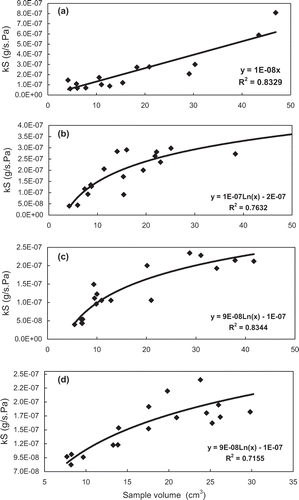
Figure 6 Adjusted curves for kS × V for different sample volumes, for the meat cuts cooled by vacuum application.
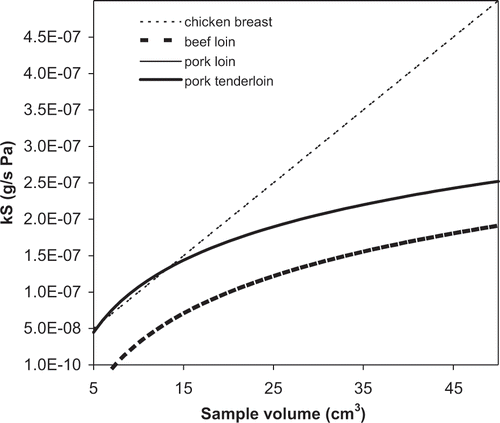
A linear behavior law representing the change in kS with V for chicken breast may be related to the more open structure of this meat if compared with the structure of the pork and beef cuts, where kS was proportional to ln(V), i.e., kS ∞ ln(V). This suggested that there is an acceptable limit for the sample size to be cooled by vacuum application, in order to obtain homogeneous cooling of the piece. For the dimension range investigated, chicken breast allowed the largest dimensions without losing the advantages of the vacuum cooling. The same equation being found for pork cuts could be merely coincidental, since cuts obtained from different parts of the same animal can have different compositions and physical structures. Since evaporation during vacuum cooling depends on the amount of water available (accessibility of internal pores), it is expected that distinct results can be obtained for different parts of the same animal.
The water evaporation inside the meat cut pores has two consequences. The first is positive and is related to the cooling homogeneity of the cut that cannot be attained with the use of air blast cooling, which generates temperature profiles that depend on the thermal diffusivity of the meat cut. The second consequence can be negative, depending on the amount of evaporated water. Great water losses can provoke texture changes and reduce meat juiciness, which is not desirable. Landfeld et al.[Citation14] did not find a dependence of the kS value on sample volume for cooked carrots and potatoes cooled by vacuum application. The highest correlation coefficient found by these authors was related to precooked chicken breast (R2 = 0.7003), for a linear fit. The assumption that the area available for water evaporation (or mass transfer area) of a food is directly proportional to its volume is not always valid. As precooked vegetables are less porous or non-porous materials, they behave differently to precooked meat during the vacuum cooling process. In starchy foods, the cooking process promotes starch gelatinization, resulting in a non‐porous material. The evaporation occurs almost exclusively at the food surface, suggesting that kS values should be proportional to the external area of the food and not to the food volume. Thus, these products should be subjected to size reduction before the application of the vacuum cooling process. Foods with accessible internal porosity (i.e., capillary partially filled with free water) allow the application of the vacuum cooling technique to large pieces because they have large evaporation areas and therefore a more uniform cooling process.[Citation4, Citation12, Citation13]
The results obtained for the kS dependence on sample volume during the cooling of packed sand samples with initial moistures of 0.10 and 0.20 g water/g of sample are given in , where high correlation coefficients were found (R2 = 0.95). Since external evaporation surfaces were the same for all samples, the results indicated that the majority of the evaporation occurred inside the samples. However, the increase in kS with sample volume was greater for the sample with an initial moisture content of 0.20 g water/g, indicating that the amount of free water is a very important parameter in controlling vacuum cooling.
Figure 7 Experimental values for kS for different sample volumes of packed sand with initial moisture contents of 0.10 and 0.20 g water/g.
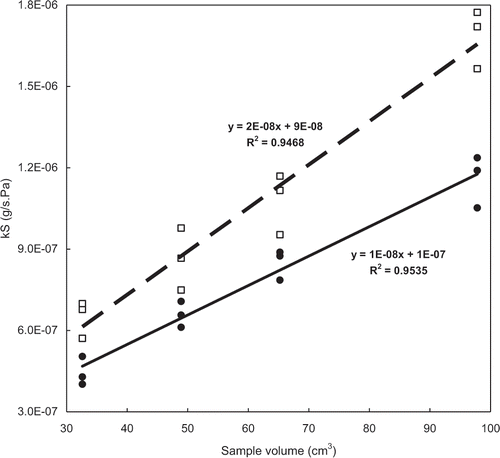
The average values for kS obtained in the experiments with sand were 7.781 × 10−7 g/s⋅Pa for the samples with initial moisture contents of 0.10 g water/g of sample and 1.069 × 10−6 g/s⋅Pa for the samples with initial moisture contents of 0.20 g water/g, that is, 37.4% greater than the former. These results demonstrated also that kS values depend strongly on the amount of free water available for evaporation. At the beginning of the process, the moisture on the product surface is evaporated, creating free spaces through which the water that evaporates inside the medium can leave and promoting an increase in the available area for evaporation.
The time-mass variation of the sample was determined numerically from the cooling curves, as represented in the algorithm of . From these data and the differences between the chamber pressure, and the water saturation pressure at a given temperature, the kS evolution was calculated during the vacuum cooling for precooked chicken breast. The curves obtained through the numeric simulation were normalized and are given in , where the time evolutions of kS, (P − Psat ) and (dm/dt) are presented. At the beginning of the cooling, when there was a rapid pressure reduction and the evaporation rates were high (due to the rapid temperature decrease), the kS value increased quickly, attaining a maximum value. As the chamber pressure decrease rate became lower, the evaporation rate decreased, which resulted in a kS decrease, despite the increase in the evaporation area. At the end of the process the driving force for phase change (P − Psat ) tends toward zero, and the evaporation ceases.
Figure 8 Results for numeric simulations of the temporal evolutions of sample mass, the difference (P−Psat ) and the kS value for the cooling of precooked chicken breast (dimensionless values).
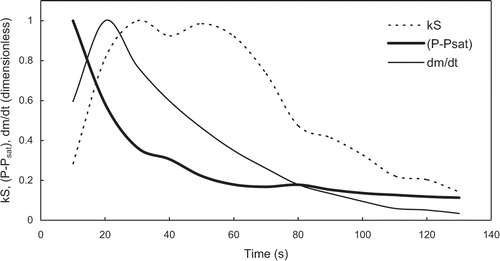
The final appearance of vacuum cooled samples of beef and chicken breast can be seen in . A more defined meat fiber can be observed, caused by the evaporation and water loss. Texture changes can present a problem in vacuum application in many cases, or can act as an advantage in some applications, as in cases where a sauce is impregnated into the meat by vacuum application (vacuum impregnation).
CONCLUSIONS
It was observed that the kS parameter presented statistical correlations with sample volume, for the meat samples investigated. The strongest dependence was found for precooked chicken breast. For pork and beef samples kS was proportional to ln(V). Knowledge of these dependences is important in order to evaluate the dimensions and geometric formats of meat cuts to be treated by vacuum cooling without losing the spatial homogeneity of cooling because it depends of the food structure. These results need to be complemented for bigger meat pieces. Experiments with cylinders filled with moist sand showed that the assumption that kS is proportional to the volume sample is correct for porous materials, and that the initial moisture content influences the internal temperatures during cooling. Knowledge of kS behavior with respect to sample volume and process time aids an understanding of the water evaporation, and the temperature drop during the vacuum cooling of porous foods.
ACKNOWLEDGMENTs
The authors thank Capes (Brazil) for financial support through the concession of the scholarship for Huber, E.
Notes
7. Afonso M.R.A. Resfriamento a vácuo de alfaces hidropônicas (Lactuca sativa L.) cv. Salad Bowl: avaliação do processo e da vida pós-colheita. PhD Thesis UNICAMP-Brazil, 2005.
REFERENCES
- Houska , M. , Podloucký , S. , Zitné , R. , Grée , R. , Sesták , J. , Dostàl , M. and Burfoot , D. 1996 . Mathematical model of the vacuum cooling of liquids . Journal of Food Engineering , 29 : 339 – 348 . [CSA]
- Mc Donald , K. and Sun , D.W. 2000 . Vacuum cooling technology for the food processing industry . A Review. Journal of Food Engineering , 45 : 55 – 65 . [CSA] [CROSSREF]
- Dostál , M. and Petera , K. 2003 . Vacuum cooling of liquids: mathematical model . Journal of Food Engineering , 61 : 533 – 539 . [CSA]
- Wang , L. and Sun , D.W. 2001 . Rapid cooling of porous and moisture foods by using vacuum cooling technology . Food Science And Technology , 12 : 174 – 184 . [CSA]
- Huber , E. and Laurindo , J.B. 2005 . Weight loss of pre-cooked chicken breast cooled by vacuum application . Journal of Food Process Engineering , 28 : 326 – 339 . [CSA] [CROSSREF]
- Martínez , J.A. and Artés , F. 1999 . Effect of packaging treatments and vacuum cooling on quality of winter harvested iceberg lettuce . Food Research International , 32 : 621 – 627 . [CSA] [CROSSREF]
- 7. Afonso M.R.A. Resfriamento a vácuo de alfaces hidropônicas (Lactuca sativa L.) cv. Salad Bowl: avaliação do processo e da vida pós-colheita. PhD Thesis UNICAMP-Brazil, 2005.
- Rennie , T.J. , Vigneault , C. , Raghavan , G.S.V. and Deell , J.R. 2001 . Effects of pressure reduction rate on vacuum cooled lettuce quality during storage . Canadian Biosystems Engineering , 43 : 39 – 43 . [CSA]
- Desmond , E.M. , Kenny , T.A. , Ward , P. and Sun , D.W. 2000 . Effect of rapid and conventional cooling methods on the quality of cooked ham joints . Meat Science , 56 : 271 – 277 . [CSA] [CROSSREF]
- Mc Donald , K. , Sun , D.W. and Kenny , T. 2000 . Comparison of the quality of cooked beef products cooled by vacuum cooling and by conventional cooling . Lebensmittel Wissenschaft Und Technologie , 33 : 21 – 29 . [CSA] [CROSSREF]
- Mc Donald , K. and Sun , D.W. 2001 . The formation of pores and their effects in a cooked beef product on the efficiency of vacuum cooling . Journal of Food Engineering , 47 : 175 – 183 . [CSA] [CROSSREF]
- Wang , L. and Sun , D.W. 2002 . Modelling Vacuum Cooling process of cooked meat—part 1: analysis of vacuum cooling system . International Journal of Refrigeration , 25 : 854 – 861 . [CSA] [CROSSREF]
- Wang , L. and Sun , D.W. 2002 . Modelling vacuum cooling process of cooked meat—part 2: mass and heat transfer of cooked meat under vacuum pressure . International Journal of Refrigeration , 25 : 862 – 871 . [CSA] [CROSSREF]
- Landfeld , A. , Houska , M. , Kýhos , K. and Jiang-Qibin . 2002 . Mass transfer experiments on vacuum cooling of selected pre-cooked solid foods . Journal of Food Engineering , 52 : 207 – 210 . [CSA] [CROSSREF]
- Huber , E. , Soares , L.P. , Carciofi , B.A.M. , Hense , H. and Laurindo , J.B. 2006 . Vacuum cooling of cooked mussels (Perna perna) . Food Science and Technology International , 12 : 19 – 25 . [CSA] [CROSSREF]
- Self , K.P. , Nute , G.R. , Burfoot , D. and Moncrieff , C.B. 1990 . Effect of pressure cooking and pressure rate change during cooling in vacuum on chicken breast quality and yield . Journal of Food Science , 55 : 1531 – 1535 . [CSA]
- Mc Donald , K. and Sun , D.W. 2001 . Effect of evacuation rate on the vacuum cooling process of a cooked beef product . Journal of Food Engineering , 48 : 195 – 202 . [CSA] [CROSSREF]
- Krokrida , M.K. , Zogzas , N.P. and Maroulis , Z.B. 2001 . Mass transfer coefficient in food processing: compilation of literature data . International Journal of Food Properties , 4 ( 3 ) : 373 – 382 . [CSA] [CROSSREF]
- Dostál , M. , Kýhos , K. , Houska , M. and Grée , R. 1999 . Vacuum cooling of solid foods . Czech Journal of Food Sciences , 17 : 103 – 112 . [CSA]
- He , S.Y. and Li , Y.F. 2003 . Theoretical simulation of vacuum cooling of spherical foods . Applied Thermal Engineering , 23 : 1489 – 1501 . [CSA] [CROSSREF]
- Zhang , Z. and Sun , D.W. 2003 . “ Experimental study on temperature and weight loss profiles of vacuum cooling of sliced cooked carrot ” . In Proceedings of 21st International Congress of Refrigeration , Washington, DC : IIR . Paper no. ICR0470
- Siebel , J.E. 1982 . Specific heat of various products . Ice Refrig , 2 : 256 – 257 . [CSA]

